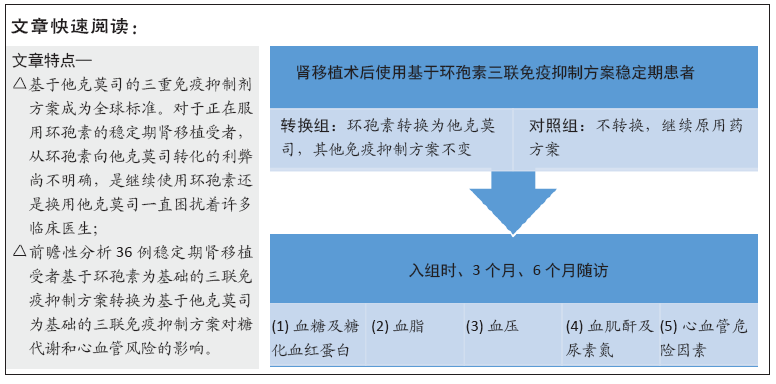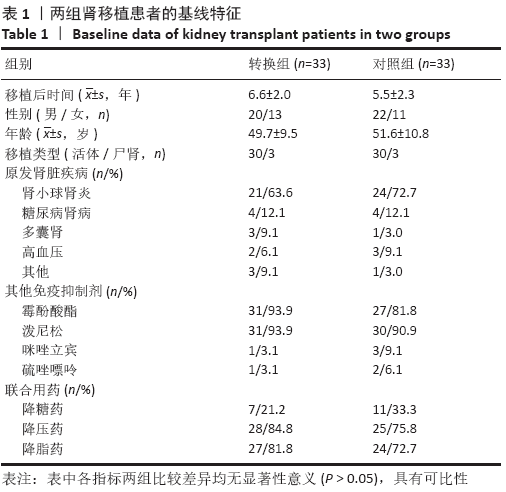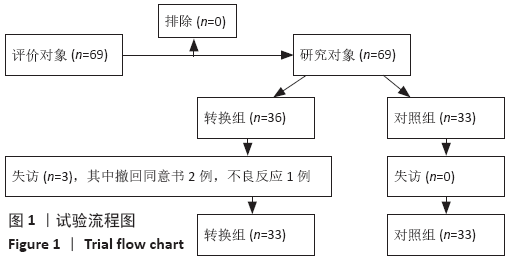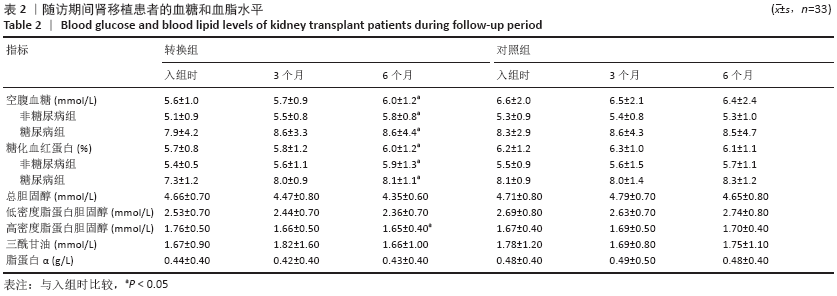[1] SUTHANTHIRAN M, STROM TB. Renal transplantation. N Engl J Med. 1994; 331(6):365-376.
[2] CHANG SH, RUSS GR, CHADBAN SJ, et al. Trends in kidney transplantation in Australia and New Zealand, 1993-2004. Transplantation. 2007;84(5): 611-618.
[3] 中华医学会器官移植学分会.器官移植免疫抑制剂临床应用技术规范(2019版)[J].器官移植,2019,10(3):213-226.
[4] ARTZ MA, BOOTS JM, LIGTENBERG G, et al. Improved cardiovascular risk profile and renal function in renal transplant patients after randomized conversion from cyclosporine to tacrolimus. J Am Soc Nephrol. 2003;14(7): 1880-1888.
[5] WEBSTER AC, WOODROFFE RC, TAYLOR RS, et al. Tacrolimus versus ciclosporin as primary immunosuppression for kidney transplant recipients: meta-analysis and meta-regression of randomised trial data. BMJ. 2005; 331(7520):810.
[6] EKBERG H, TEDESCO-SILVA H, DEMIRBAS A, et al. Reduced exposure to calcineurin inhibitors in renal transplantation. N Engl J Med. 2007;357(25): 2562-2575.
[7] ROLAND M, GATAULT P, DOUTE C, et al. Immunosuppressive medications, clinical and metabolic parameters in new-onset diabetes mellitus after kidney transplantation. Transpl Int. 2008;21(6):523-530.
[8] 冯小芳,闵敏,左富姐,等.他克莫司转换为环孢素A改善肾移植后新发糖尿病[J].中国组织工程研究,2013,17(53):9176-9181.
[9] KASISKE BL, ZEIER MG, CHAPMAN JR, et al. KDIGO clinical practice guideline for the care of kidney transplant recipients: a summary. Kidney Int. 2010; 77(4):299-311.
[10] 中华医学会器官移植学分会.中国移植后糖尿病诊疗技术规范(2019版)[J].器官移植,2019,10(1):1-9.
[11] MA YC, ZUO L, CHEN JH, et al. Modified glomerular filtration rate estimating equation for Chinese patients with chronic kidney disease. J Am Soc Nephrol. 2006;17(10):2937-2944.
[12] JEVNIKAR A, ARLEN D, BARRETT B, et al. Five-year study of tacrolimus as secondary intervention versus continuation of cyclosporine in renal transplant patients at risk for chronic renal allograft failure. Transplantation. 2008;86(7):953-960.
[13] 刘永光,郭颖,李留洋,等.慢性移植肾肾病患者使用他克莫司联合麦考酚吗乙酯替代环孢素为基础的免疫抑制剂方案的疗效分析[J].器官移植,2019,1(6):342-344.
[14] 祝藩原,曾力,温燕,等.肾移植受者将环孢素A转换为他克莫司治疗的三年疗效分析[J].中华器官移植杂志,2011,32(9):527-530.
[15] BALLA A, CHOBANIAN M. New-onset diabetes after transplantation: a review of recent literature. Curr Opin Organ Transplant. 2009;14(4):375-379.
[16] 石炳毅,王振,郑慧丽,等.肾移植受者远期心脑血管疾病危险因素分析[J].中国医学科学院学报,2009,31(3):284-287.
[17] WISSING KM, ABRAMOWICZ D, WEEKERS L, et al. Prospective randomized study of conversion from tacrolimus to cyclosporine A to improve glucose metabolism in patients with posttransplant diabetes mellitus after renal transplantation. Am J Transplant. 2018;18(7):1726-1734.
[18] BLOOM RD, CRUTCHLOW MF. New-onset diabetes mellitus in the kidney recipient: diagnosis and management strategies. Clin J Am Soc Nephrol. 2008;3 Suppl 2(Suppl 2):S38-48.
[19] LANKARANI KB, ESHRAGHIAN A, NIKEGHBALIAN S, et al. New onset diabetes and impaired fasting glucose after liver transplant: risk analysis and the impact of tacrolimus dose. Exp Clin Transplant. 2014;12(1):46-51.
[20] LUAN FL, STEFFICK DE, OJO AO. New-onset diabetes mellitus in kidney transplant recipients discharged on steroid-free immunosuppression. Transplantation. 2011;91(3):334-341.
[21] SHIVASWAMY V, BOERNER B, LARSEN J. Post-Transplant Diabetes Mellitus: Causes, Treatment, and Impact on Outcomes. Endocr Rev. 2016;37(1): 37-61.
[22] 杨进,张美霞,闫沛,等.肾移植后新发糖尿病危险因素的Meta分析[J].中国组织工程研究,2019,23(15):2450-2460.
[23] 张蓬杰,张志明,杜鹏,等.他克莫司转换为环孢素对肾移植术后新发糖尿病的影响[J].山西医科大学学报, 2015,46(12):1230-1234.
[24] GERVASINI G, LUNA E, GARCÍA-CERRADA M, et al. Risk factors for post-transplant diabetes mellitus in renal transplant: Role of genetic variability in the CYP450-mediated arachidonic acid metabolism. Mol Cell Endocrinol. 2016;419:158-164.
[25] SHIHAB FS, WAID TH, CONTI DJ, et al. Conversion from cyclosporine to tacrolimus in patients at risk for chronic renal allograft failure: 60-month results of the CRAF Study. Transplantation. 2008;85(9):1261-1269.
[26] 刘克普,易晓敏,马帅军,等.他克莫司和环孢素A对肾移植后患者炎性细胞因子和血脂的影响[J].中国组织工程研究与临床康复,2011, 15(31):5769-5772.
[27] 黄燕纯,龙文,黄新坚,等.钙神经蛋白抑制剂慢性肾毒性模型的建立方法及进展[J].器官移植,2015,5(2):124-126. |






